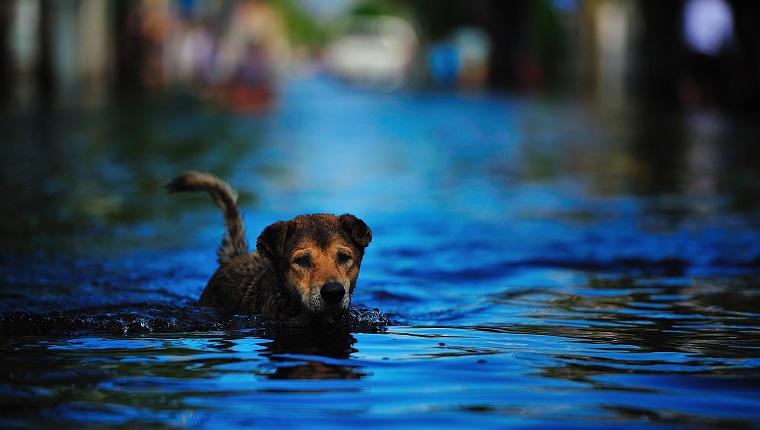Anyone who’s watched a flash flood wash away a house in minutes knows the destructive power of these natural disasters. Flooding can be a very frightening situation for people and their dogs, but there are thankfully many ways to prepare for this weather event.
The best thing dog parents can do for their pets in the event of a flood is to have a plan and follow it safely. Dogs look to their caregivers for guidance and reassurance, especially when something goes wrong.
Understanding what to do before, during, and after a disaster with your dog may help you protect your pets and give everyone in your home a better chance at safety.
Before The Flood

People who live in areas where flooding is fairly common need to prepare for floods each year. Just because it doesn’t always happen is no indicator that it will not happen at any given time.
Taking the opportunity to confirm that you’re protecting your home and pets gives you the best chance to keep everyone safe. Planning deliberately and avoiding procrastination is often the most effective method to avoid damage or heartache during a disaster.
There are many different types of floods, and the way that they progress may be quite different from one experience to the next.
Some pet parents may recount tales of a flash flood that arrived in minutes and receded relatively quickly. Others might talk about rains that rose to a foot deep but remained for days on end.
In all cases, households need to have a plan to take quick action. Some storms produce rainfall that turns into a wall of water many feet high.
The National Weather Service notes that it only takes 6″ of water to sweep a person off their feet, and 24″ to move a car. People must remember the danger of losing control or drowning in such waters, particularly when they have pets.
Make A Flood Preparation Plan
A flood preparation plan with dogs should include the following:
- Be ready to put dogs on a leash or in a carrier
- Designate a safe area (with a backup location) and go there before a flood hits
- Stock the safest room with food, water, and gear for residents and pets
- Keep records about dogs in a place where they’re easy to grab quickly
- Turn on an alert system like the NOAA radio station to gather information about the flood’s progress
Periodically, dog parents may need to go through the routine with their dogs. This will help to establish a habit that decreases stress when a flood happens.
Find A Way To Get Alerts
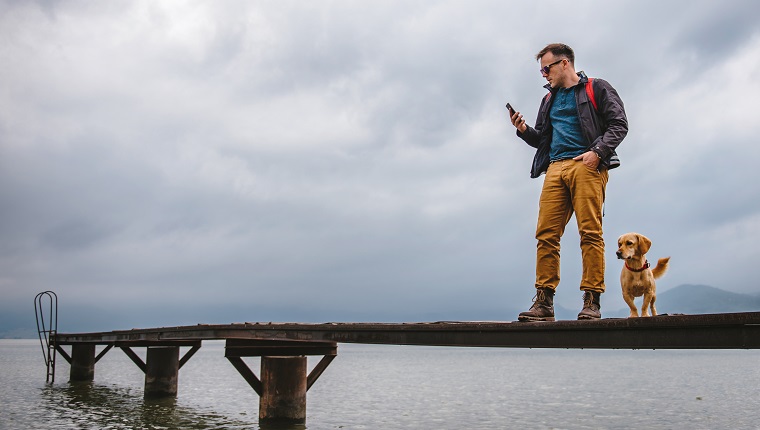
In disasters where people may be confined to their homes with their dogs for days, finding information is key for safety. It may look as though the storm has receded or that the situation is getting better when, in fact, it’s getting worse.
Organizations like the National Oceanic and Atmospheric Administration publish alerts and updates about large, destructive events like hurricanes. Local news and government authorities may also pass along details as they get them.
Households should ideally use more than one method to get information. Relying on a smartphone or computer is only useful so long as the battery is charged and the internet service is working.
People may also want to keep a battery-operated radio with their flood-preparation gear to ensure they have multiple ways of assessing the situation.
Protect Your Home
Flood waters can rise quickly and do damage to the house within moments. Homeowners can minimize some of this damage by performing a few home improvement and maintenance tasks regularly:
- Install a sump pump and test it yearly
- Grade the property to allow water to drain away from the house
- Test the sewer backflow preventer and install a better one if needed
- Keep soil around the foundation moist even during dry periods
- Clear gutters and ensure downspouts point away from the home
- Resolve leaks, especially those related to the foundation
Households should keep in mind that flood insurance is usually not provided as part of their regular coverage. As such, flooding from a hurricane or other natural event may not be covered.
During Active Flooding
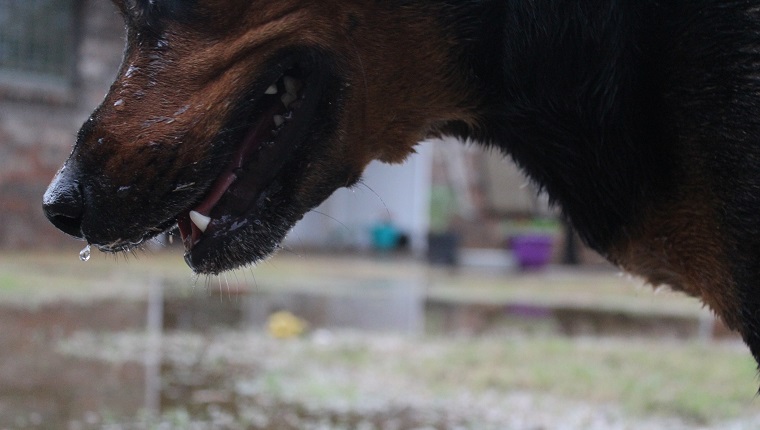
When flood waters begin to rise, dog parents may have anywhere from a few minutes to several hours in which to prepare and take action. It is often difficult to predict how much time someone has to make choices.
This underscores the importance of having a flood plan in place and following it in the moment. Keeping security in mind and always proceeding with caution will help you ensure the safety of yourself and your pets.
Find A Safe Place For Pets
In many cases, evacuation is the best approach for people who live in an area that has active flooding. Even if the water is only a few inches deep, it can still pose serious dangers to people and pets, inside or outside the house.
Before flood waters arrive, you should look for places near your home that are located on higher ground. If you consider staying at a nearby hotel, you should confirm that the place will accommodate dogs of your pets’ sizes and breeds.
When households are not under an evacuation order yet, you may want to relocate important equipment away from the basement or main floor of the house. This includes items such as:
- Food for people and pets
- Sealed water containers (to prevent contamination)
- Technological equipment and chargers
- Dog carriers, crates, or beds
This will help to provide a space to wait for more information.
Leave Quickly
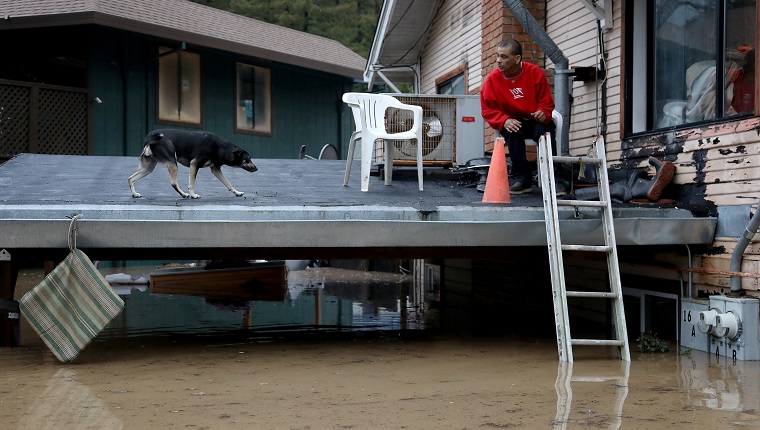
One scary thing about floods is that their status can change with no warning, and each stage has a highly variable time period. The water might come in a large wall that destroys almost everything in its path, or an inch at a time.
The only reliable thing that people can predict is that water rolls downhill.
Staying at home can seem like a better idea prior to an evacuation order, simply because it feels more familiar to dogs. However, staying put for longer may not be the best approach.
People who are counting on staying at a hotel or with family and friends during a flood may lose that opportunity as the waters rise or change course. A pet-friendly hotel might fill up quickly, and the few roads out of town may become blocked with water or traffic.
Instead, households might prefer to get ready and leave for safety at the earliest indication they may need it. You should keep your dogs nearby and ready to go in a moment.
When floods are imminent, it’s best not to tether or lock pets in cages outside. This makes it harder for them to find safety if they need to do it on their own.
When Evacuation Is Not Possible
Some households cannot evacuate from their homes with their pets. They may be unable to leave the area, or in a situation where the flood waters rose so quickly they cannot leave the home.
In these cases, the best thing to do is to unplug appliances and stay at the house, above the water. Some people go to their attic because it’s the highest point, but this can be extremely dangerous.
If you cannot stay on the main level of your home and cannot get away from the property safely, you should go to the roof.
You should avoid trying to cross a flood by swimming with your dogs or using your car. These waters are very strong and may have a current that pulls people and pets under water.
Even large, heavy cars can float or be swept away by water that’s deep enough. If you cannot drive or walk on relatively dry land, you may need to stay at home until rescue vehicles arrive.
After The Flood Has Passed
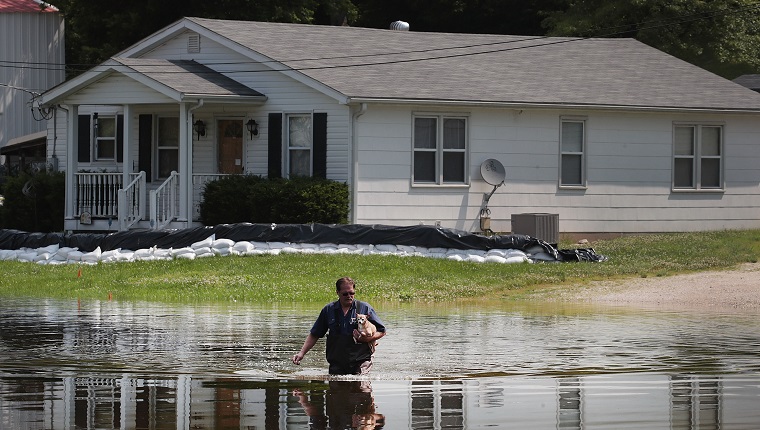
Like many other natural disasters, the effects of a flood can last for weeks or months after the water drains away.
In the first few days after a flood, dog parents should watch carefully for hazards that may injure themselves or their dogs. Keeping everyone in a safe place until authorities can declare a home safe for occupation and asking for support quickly can make a big difference in recovery.
Remain Safe
One of the biggest risks that people take in the aftermath of a serious weather event is to leave a place of safety to scope out the damage.
If people are waiting for a rescue crew to retrieve them from the top of the roof, leaving the area as soon as possible makes sense.
Dog parents who already evacuated to a location that’s not flooded must stay put until local or national weather experts say that the threat has passed. They should continue to present a controlled demeanor to help their dogs remain calm.
People must balance their ability to take control with their need to protect themselves. This may mean paying for a few extra days at a hotel or not getting an opportunity to look at the house quite yet.
This can help avoid overwhelming local services that are already stressed by the disaster and help people keep themselves and their dogs in good health.
Look For Hazards
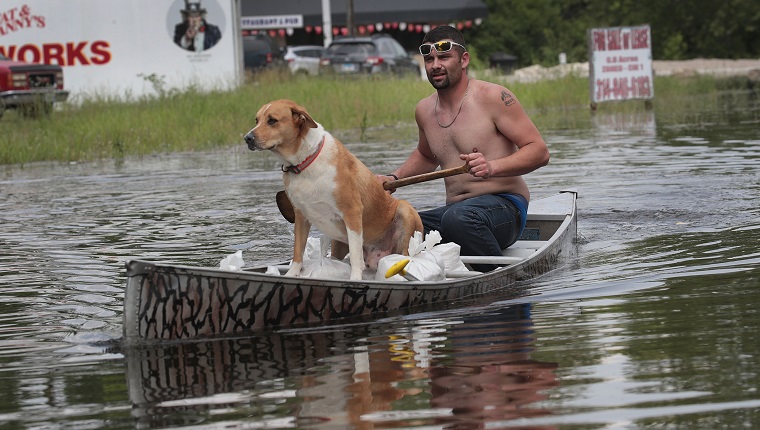
In a disaster area, all bets are off. When emergency personnel are stretched too thin, there may be active hazards on the ground for hours or even days.
Dog parents should assume that every foot of ground near their houses may present certain dangers. For example, downed power lines near a flood can be a common source of electrocution.
Flood waters are usually unsafe for drinking or submersion. Dogs often know how to swim, but the current and the contents of the water are unpredictable and possibly dangerous. The water may contain toxic substances or wild animals.
People and their dogs should not drink water or eat food that becomes submerged in the flood. Don’t forget that areas like basements can become especially dangerous after a flood, and any damage will need to be repaired as soon as possible.
Standing water can become a breeding ground for mosquitoes, which may cause health problems like heartworm in dogs. Exposed wires or appliances that have been soaked may shock those who come into contact with them.
A professional service may be the safest way to deal with major mold, electrical, or structural issues in the home.
Request Assistance
It’s always okay to seek help. The sooner people ask for assistance, the quicker they can receive it.
Lost dogs can often be found through local pet rescue organizations. People may need pictures or records about a dog’s immunizations in order to retrieve them.
A home that sustained significant water damage needs restoration services before it can become a residence again. Water seeps into walls quickly and can breed mold that’s harmful to people and pets.
The structure might collapse, as well. During this time, people must not leave their pets or let them roam around the property.
Homeowners should take a copy of their homeowners insurance policy and confirm that this type of flooding is covered by their plan. Then, they can file a claim and request an insurance adjuster to visit the property and identify the extent of the damage.
They may also look for any possible financial assistance that may be offered to them after a flood.
Seeing flood waters rise can be a scary time for humans and their dogs. Finding a way out early is key, as well as remaining calm and sticking to a plan. By following this advice, pet parents can provide additional protection for their dogs and their homes.
Do you have any other tips for preparing for a flood and keeping your dog safe? Have you ever had to get away from a disaster with your pets? Let us know in the comments below!
